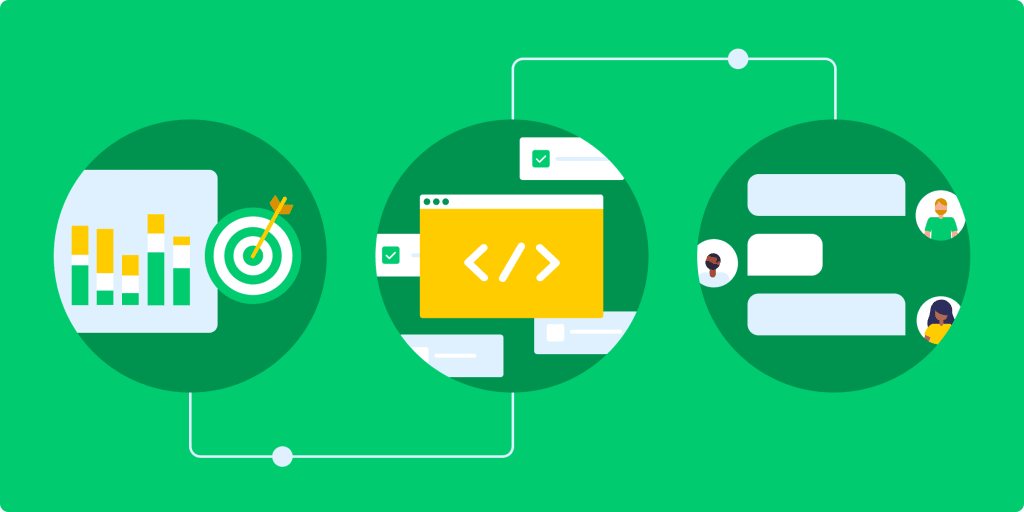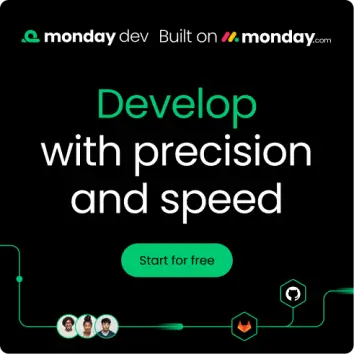Bringing a new product to life is exciting, but it’s rarely simple. An idea might feel full of potential at the start, yet turning it into something customers genuinely want to use involves balancing priorities, keeping teams aligned, and adjusting to challenges along the way.
The product development process gives structure to that journey. It connects creativity with strategy and execution so teams can maintain momentum, reduce friction, and deliver results on time. With the right approach, ambitious concepts become successful launches that drive real impact.
In this guide, we’ll explore what product development looks like in 2025. You’ll learn the key stages every team goes through, the methods that help work move forward smoothly, and the structures that keep cross-functional collaboration on track. By the end, you’ll have a clear framework for turning ideas into products with more confidence and less chaos.
Key takeaways
- Seven stages shape the process: Product development moves from idea to launch in 7 steps, but success relies on building the right team and choosing a methodology that fits your project’s needs.
- Research and validation matter most: Many product failures happen when teams skip testing, so always confirm that people want what you’re building before investing significant time and resources.
- Visibility solves common challenges: Issues like misalignment and slow progress can be overcome with centralized platforms such as monday dev, which offers flexible workflows and real-time dashboards.
- Methodologies should fit the context: Agile works best when requirements are changing, waterfall suits fixed projects, lean helps validate ideas quickly, and RAD is ideal when speed is the top priority.
- Metrics guide smarter decisions: Track efficiency measures like time to market and costs alongside effectiveness measures such as customer satisfaction and feature usage to understand true performance.
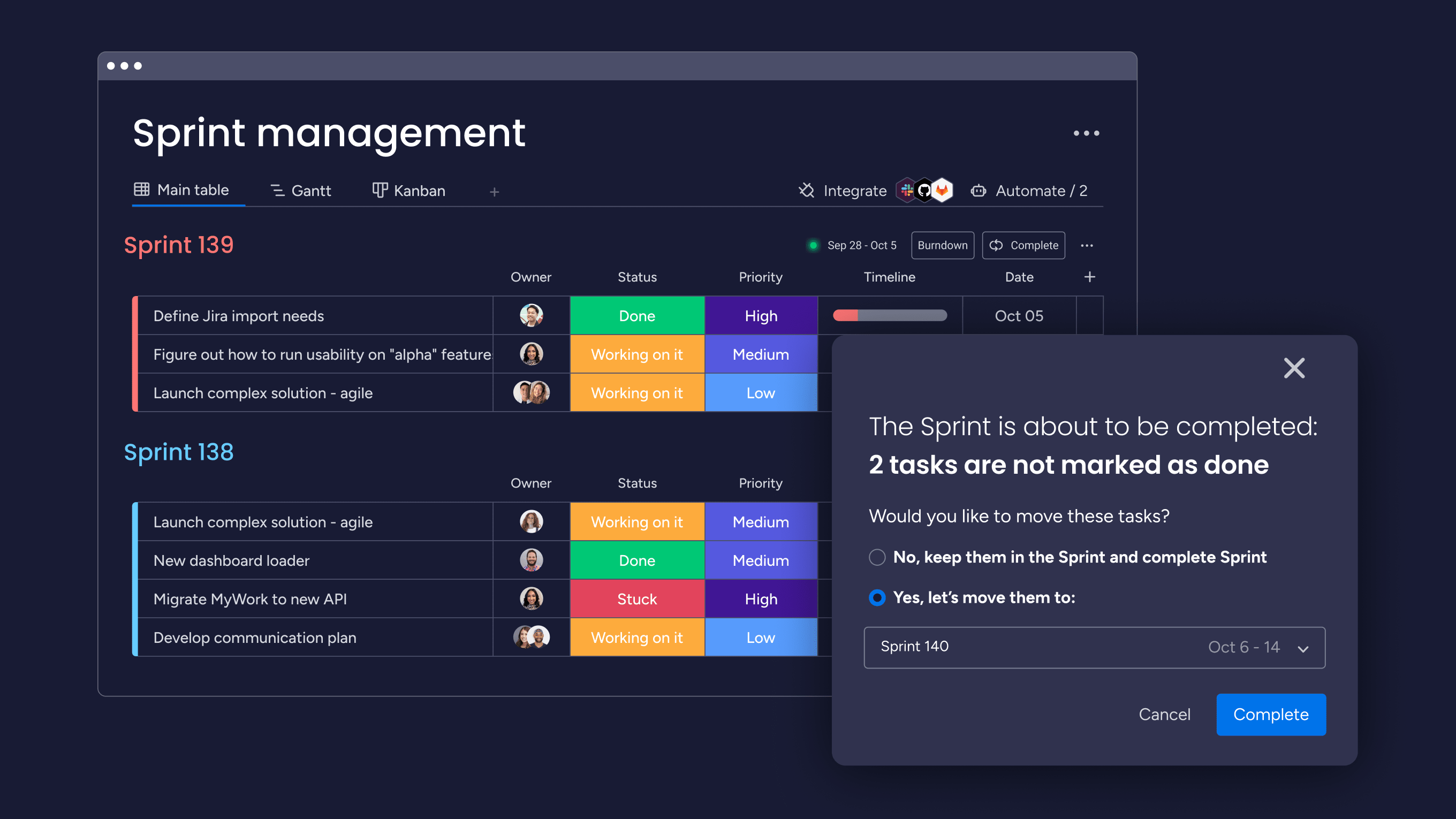
What is product development?
Product development is the complete process of bringing a new product from idea to market launch — a journey that on average takes about 2 years to complete. This means taking a concept through design, building, testing, and finally making it available to customers.
Think of it as the journey from “what if we built this?” to “here’s your new product.” Every successful product you use went through this process — from your smartphone to your favorite software platform.
The core components that make up product development include:
- Ideation: coming up with new product ideas based on what customers need.
- Design and prototyping: creating early versions to test your ideas.
- Development: actually building the product with all its features.
- Testing and validation: making sure everything works as planned.
- Launch: getting your product into customers’ hands.
The 7 stages of product development
Most successful products follow 7 distinct stages from concept to market. Understanding these stages will really help you stay organized and deliver products that actually solve customer problems.
1. Ideation and concept generation
This is where you generate new product ideas. You might get inspiration from customer complaints, market gaps, or team brainstorming sessions.
The best ideas come from real problems, a process often known as product discovery. Listen to what customers struggle with, watch how they use existing products, and identify patterns in their feedback.
2. Market research and validation
Market research means checking if people actually want what you’re planning to build. You need to understand your target customers, what they’ll pay, and who else is solving similar problems.
This step ensures you invest in building a product that has a ready and willing market. A proof of concept can help you validate ideas before investing serious time and money.
3. Product definition and planning
For the next step you need to translate your validated idea into a detailed plan: this means deciding exactly what features to include, how the product will work, and what resources you’ll need.
Clear product definition prevents scope creep later. Creating a product requirements document ensures everyone knows what you’re building and why, so development runs much smoother.
4. Design and prototyping
Prototyping means creating early versions of your product. These can be simple sketches, clickable mockups, or basic working models that show key features.
Prototypes let you test ideas cheaply. You can gather feedback and fix problems before committing to full development. Use a Kano model template to prioritize features that impact customer satisfaction.
5. Development and testing
This is where you build the actual product. Your team codes software, manufactures hardware, or creates whatever form your product takes.
Testing happens throughout development, not just at the end. Regular testing catches problems early when they’re easier to fix.
6. Launch and commercialization
Launch means making your product available to customers. This includes marketing campaigns, sales training, and setting up customer support.
A successful launch requires coordination across teams. Marketing, sales, and support all need to be ready when your product goes live.
7. Post-launch optimization
Product lifecycle management doesn’t end at launch. Teams need to capture feedback, monitor performance, and prioritize new features as customer needs evolve.
Platforms like monday dev make this easier by centralizing feedback, tracking requests, and planning improvements within the same workspace used to manage development.
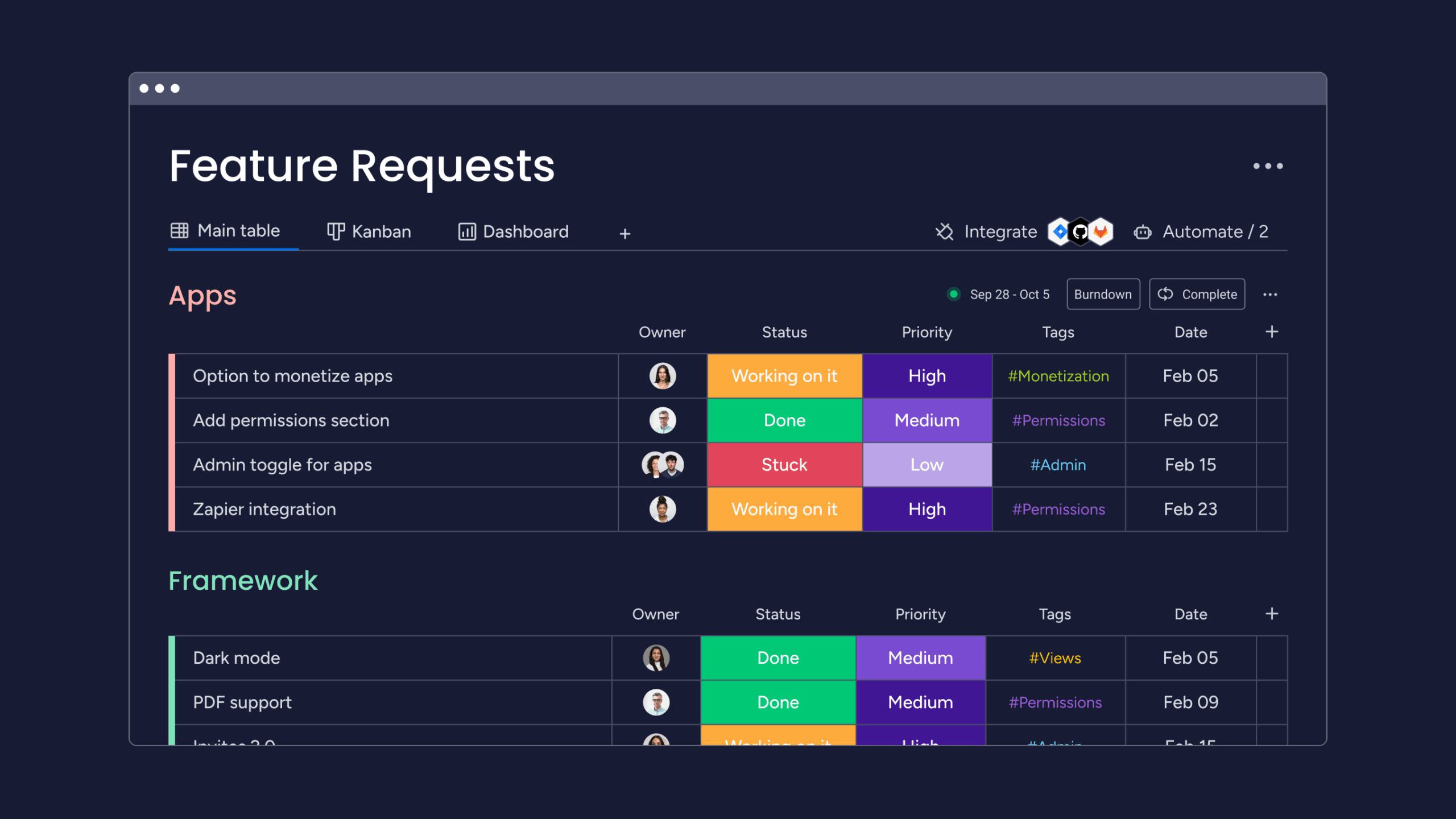
Product development vs product management explained
Product development focuses on building the product itself, while product management guides the strategy behind what gets built and why. Both are essential, but they play very different roles in bringing ideas to market.
Product managers shape the vision, define priorities, and build the roadmap. Developers, designers, and engineers then turn those plans into reality. On platforms like monday dev, these 2 perspectives connect in one place — roadmaps and strategy flow directly into the development team’s workflows, creating visibility and alignment from planning through execution.
What are the 4 product development methodologies?
How a team approaches product development can make the difference between smooth progress and constant setbacks. The right methodology shapes everything from how quickly you can adapt to change, to how thoroughly you plan upfront, to how often customers get to weigh in along the way. There’s no one-size-fits-all approach, but understanding the main options helps you choose a framework that fits your product, your team, and your goals.
1. Agile product development
Agile breaks work into short sprints, usually 2 to 4 weeks. Teams deliver working features regularly and adjust based on feedback.
This approach works great when requirements might change as you can pivot quickly without wasting months of work.
2. Waterfall development
Waterfall follows a strict sequence: finish one phase completely before starting the next. You plan everything upfront, then execute in order.
Use waterfall when requirements are fixed and changes are expensive (think construction projects or regulated industries).
3. Lean product development
Lean focuses on eliminating waste and validating ideas quickly. You build the minimum viable product first, then improve based on customer feedback.
This methodology helps you avoid building features nobody wants. Test your assumptions before investing heavily.
4. Rapid application development
Rapid application development emphasizes speed through prototyping and user involvement. You get working versions in front of users fast, then iterate based on their feedback.
Choose RAD when time-to-market matters most. It’s perfect for projects where you can refine requirements through user interaction.
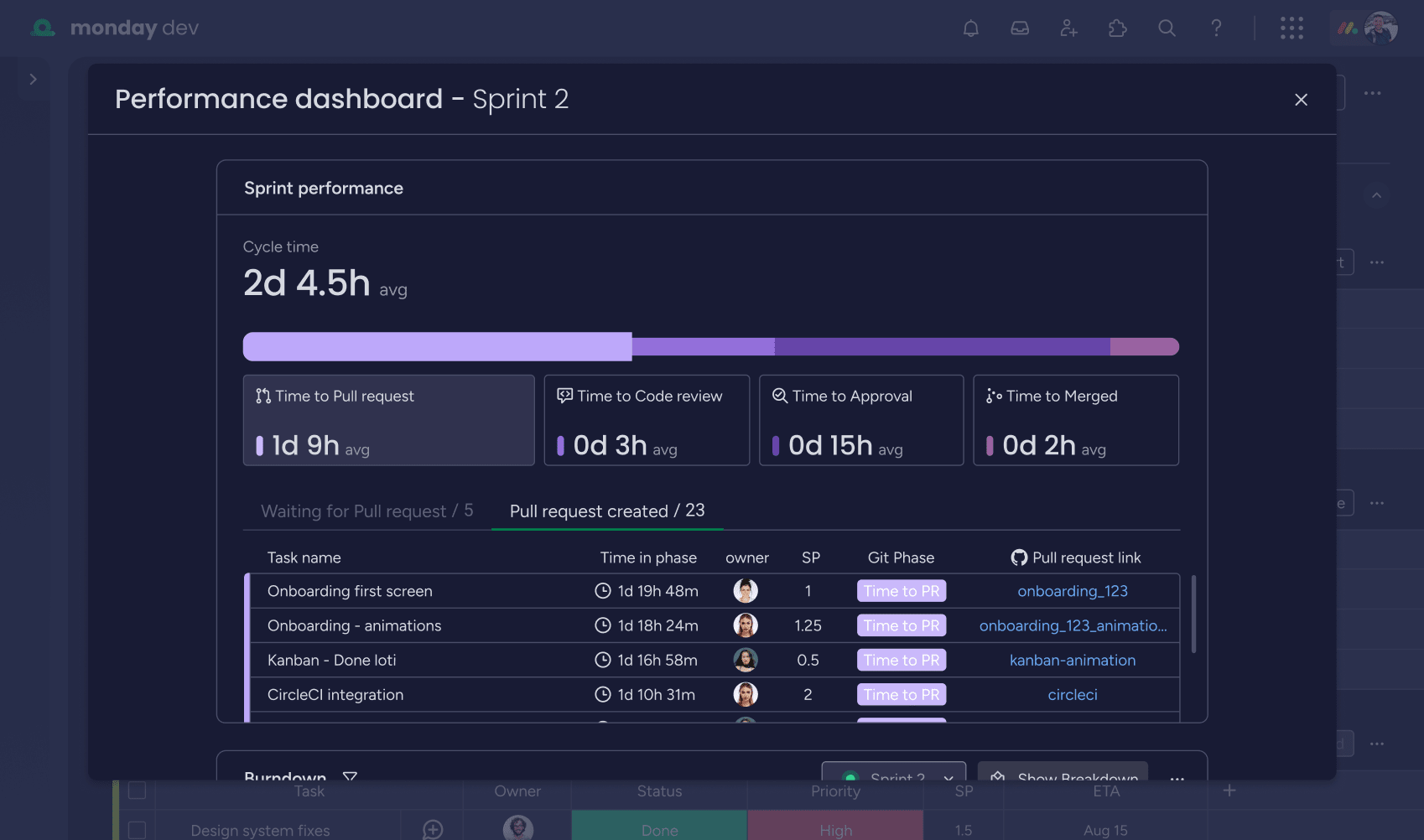
How to build your product development team
Great products don’t come from individuals working in isolation: they’re the result of teams that bring different skills together and stay aligned on a shared vision. Building that kind of team means understanding the roles that make product development work and how they fit together.
Below, we’ve broken down the key functions involved in product development, from product management and design to engineering, QA, and leadership, showing how each contributes to turning ideas into successful products.
Product managers
Product managers own the product vision and product strategy. They decide what to build based on customer needs and business goals.
They’re the bridge between customers, business stakeholders, and development teams. Good product managers keep everyone aligned and focused on delivering value.
Development teams
Development teams turn ideas into reality. This includes software engineers, hardware specialists, and anyone else who builds the actual product.
Modern development teams often include:
- Software engineers: write code and implement features.
- QA engineers: test products to ensure quality.
- DevOps engineers: manage deployment and infrastructure.
Design teams
Designers shape how customers experience your product. They research user needs, create interfaces, and ensure products are both useful and delightful.
Design isn’t just about making things look good. It’s about making products that solve problems intuitively.
Quality assurance
QA teams ensure your product works as intended. They test features, find bugs, and verify that everything meets quality standards.
Good QA catches problems before customers do. This protects your reputation and reduces support costs.
Leadership and stakeholders
Leaders provide direction and resources. They ensure development efforts align with business strategy and remove obstacles for teams.
Effective leadership creates an environment where teams can do their best work. They balance giving guidance with allowing autonomy.
How to create a product development plan in 3 steps
A product development plan gives structure to big ideas, turning vision into an actionable path forward. Without one, teams risk chasing priorities that don’t align, missing deadlines, or losing sight of what customers actually need. With the right plan in place, everyone understands where the product is headed, how progress will be measured, and what it takes to get there.
Below, we’ve outlined 3 steps that help you build a product development plan that actually works — from setting a clear vision to mapping a realistic roadmap and defining the metrics that will keep your team motivated and on track.
Step 1: Define product vision and objectives
Start with a clear vision of what you’re building and why. What problem does your product solve? Who will use it? How will you measure success?
Your vision guides every decision throughout development. Make it specific enough to be useful but flexible enough to allow for learning.
Step 2: Map your development roadmap
Your product roadmap shows what you’ll build and when. Prioritize features based on customer value and dependencies between different parts of your product.
Good roadmaps balance ambition with reality. Plan for the unexpected and build in buffer time for inevitable surprises.
Step 3: Establish success metrics
Define how you’ll measure success before you start building. Choose metrics that reflect real customer value, not just activity.
Track both leading indicators (early signals) and lagging indicators (final results). This helps you course-correct quickly when needed and boosts team morale, as the World of Work report from monday found that employees who understand how success is measured are twice more likely to feel motivated.
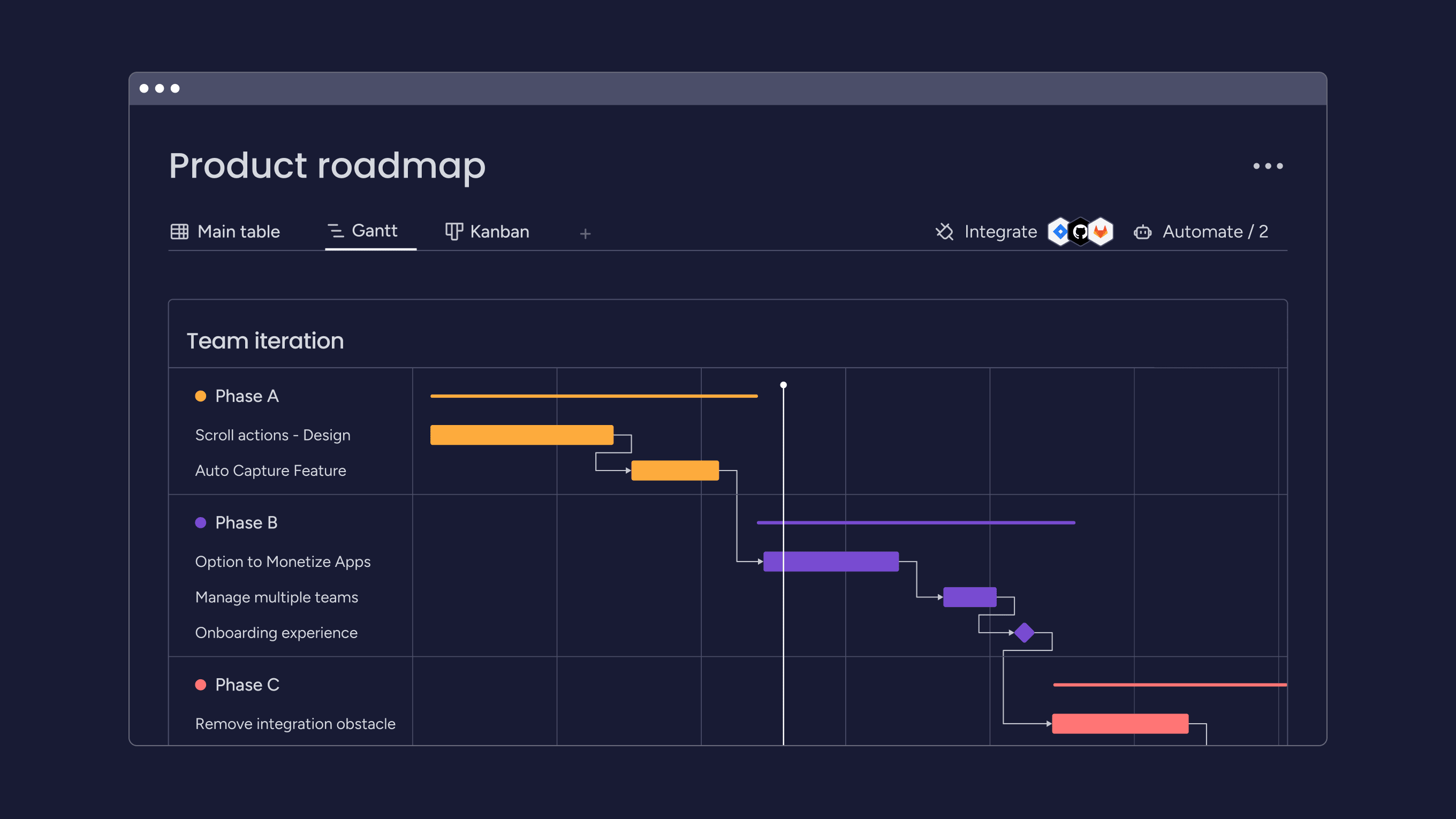
4 common product development challenges and solutions
No matter how skilled the team or how strong the plan, product development rarely runs without obstacles. Miscommunication, shifting priorities, and competing demands can slow progress and frustrate teams. The key is recognizing these hurdles early and having a clear approach for addressing them.
Below, we’ve highlighted 4 of the most common challenges that teams face during development, along with practical solutions to keep projects on track and moving forward.
Misalignment between teams
When teams work in silos, they often build incompatible pieces. According to a Runn.io teamwork survey, 86% of professionals blame a lack of workplace collaboration for project failures. For example, marketing might promise features that development can’t deliver, or design might create interfaces that are technically impossible.
Lack of visibility into progress
Without clear visibility, problems hide until they become crises. You can’t fix what you can’t see.
Create dashboards that show real-time progress. Make blockers visible so teams can help each other quickly.
Slow time to market
Slow development means missed opportunities. While you’re perfecting features, competitors might beat you to market.
Speed up by eliminating unnecessary steps and running parallel workstreams. Automate repetitive processes so teams can focus on high-value work.
Resource management issues
Poor resource allocation creates bottlenecks. Some team members get overloaded while others wait for work.
Balance workloads by tracking capacity and adjusting assignments. Use platforms that show who’s available and what skills they have.
Measuring success in product development
A product can only improve if you know how well it’s performing. Measuring success means looking beyond output to understand both how efficiently the team is working and how much value the product delivers to customers. The right mix of metrics gives a complete picture of progress and highlights where to adjust for better results.
Key performance indicators
Good key performance indicators (KPIs) balance process metrics with outcome metrics. Track development velocity alongside customer satisfaction to get the full picture.
It’s also important to focus on metrics that drive action. If a metric doesn’t help you make decisions, it’s probably not worth tracking.
Customer feedback metrics
Customer feedback tells you if you’re building the right things. Track satisfaction scores, adoption rates, and feature usage to understand what’s working.
Numbers alone don’t tell the whole story. Combine quantitative metrics with qualitative feedback for deeper insights.
Time and cost efficiency
Efficiency metrics help you deliver more value with available resources. Track time to market, development costs, and return on investment.
Remember that fastest isn’t always best. Balance speed with quality to build products that last.
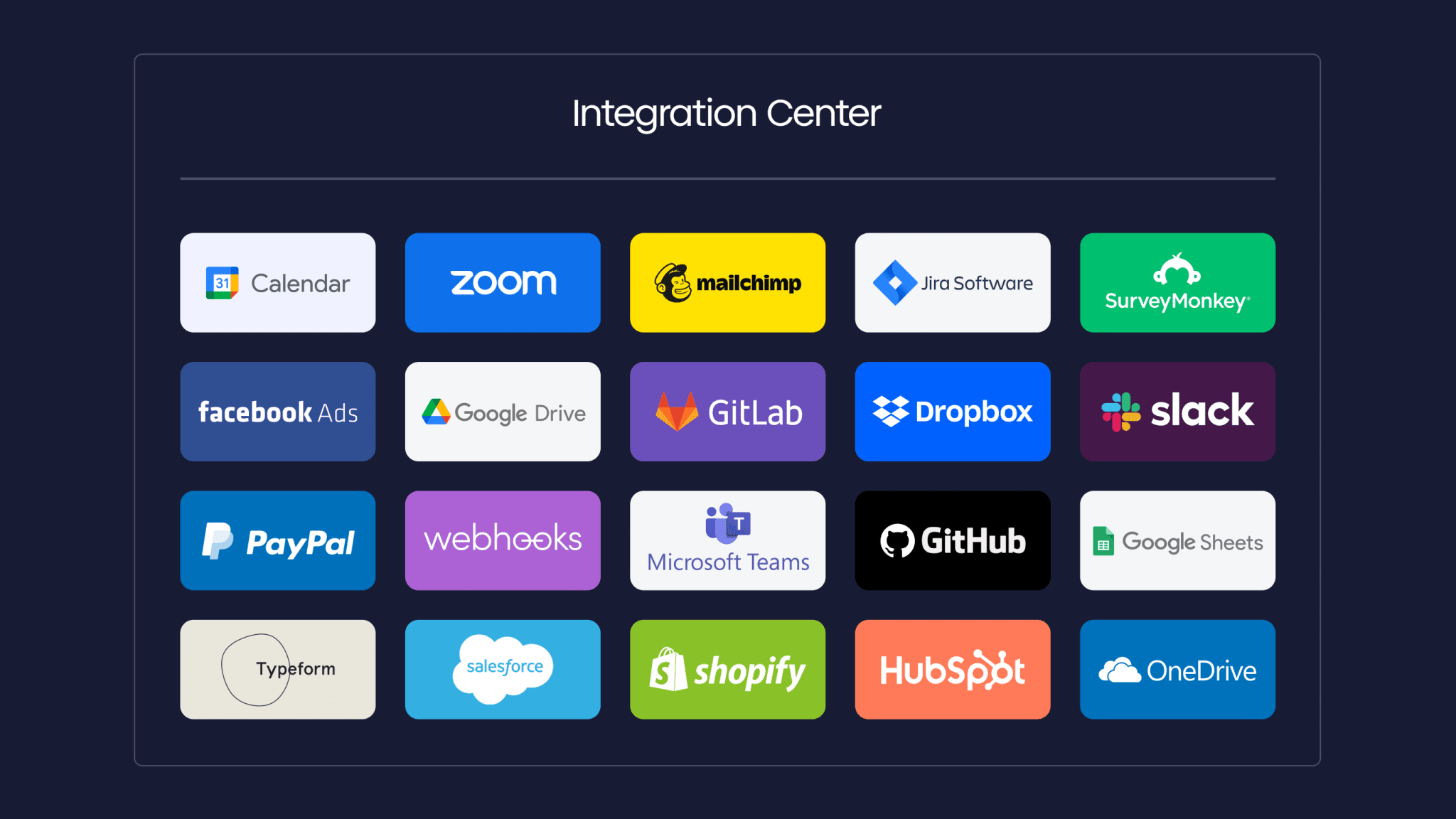
Product development examples across industries
Different industries face unique challenges in product development. Here’s how various sectors approach the process:
Software and technology
Software teams can update products quickly after launch. This allows for rapid iteration based on user feedback.
Most software teams use Agile methodologies. They release features incrementally and improve based on real usage data.
Manufacturing and hardware
Physical products require more upfront planning. Changes after production starts are expensive or impossible.
Manufacturing teams often use hybrid approaches. They iterate during design but follow stricter processes once production begins.
Service-based products
Services focus on experiences rather than tangible products. Development means designing processes and training people to deliver consistently.
Service development requires special attention to human factors. Every customer interaction shapes the product experience.
Transform your product development with monday dev
Successful product development depends on clear priorities, strong collaboration, and tools that adapt as your process evolves. monday dev brings all of this together in a single flexible platform, connecting strategy, workflows, and visibility so teams can move forward with confidence.
With support for multiple methodologies, real-time dashboards, and AI-powered insights, monday dev gives teams everything they need to deliver products faster and with less friction.
Flexible workflows for any methodology
Whether you use Agile, waterfall, or something in between, monday dev adapts to how you work. Create custom workflows that match your process exactly with drag-and-drop builders, 20+ column types, and pre-built templates for Scrum, Kanban, and SAFe frameworks.
Give your team the freedom to work with a system that adapts to their needs. Customize dev boards with sprint planning views, epic roadmaps, and backlog prioritization tools that evolve as your process matures.
Real-time collaboration and visibility
Keeping everyone aligned is easier when work is transparent and progress is visible in real time. monday dev gives teams a clear view of what’s happening across projects so they can collaborate seamlessly and address issues before they slow things down.
- Dashboards that update automatically: track progress as it happens, without needing manual updates.
- Git and GitHub integrations: sync code changes directly to your workflow boards so developers and stakeholders stay connected.
- Dependency tracking: spot blockers early and remove them before they become bottlenecks.
- Shared workspaces: create alignment across teams with a single source of truth.
- Built-in documentation hub: keep critical information accessible and organized in one place.
When visibility improves, collaboration strengthens, and teams can solve problems faster together.
AI-powered development insights
Let AI analyze your development patterns and suggest improvements with monday AI. Spot potential delays before they happen using predictive burndown charts, velocity tracking, and sprint health indicators that flag at-risk deliverables automatically.
Smart automation handles routine tasks through 200+ app integrations and customizable automation recipes so your team can focus on creative problem-solving. Automate status updates, task assignments, and approval workflows, joining the 86% of IT professionals who use AI to enhance their workflows. That’s how you ship exceptional products faster.
Frequently asked questions
What are the 4 major types of product development methodologies?
The four major product development methodologies are Agile (iterative sprints with regular feedback), Waterfall (sequential phases completed in order), Lean (minimize waste while maximizing value), and Rapid Application Development (fast prototyping with user involvement).
Is product development the same as product management?
Product development and product management are different roles — product development focuses on building products through design and engineering, while product management handles strategy, planning, and coordination across teams.
How long does the typical product development process take?
Product development timelines vary widely based on complexity and industry, ranging from a few months for simple software features to several years for complex hardware or pharmaceutical products.
What is the difference between product development and product design?
Product development covers the entire journey from concept to market launch, while product design specifically focuses on creating the user experience and visual interface within that larger process.
How much does product development typically cost?
Product development costs depend on complexity, team size, and timeline, ranging from thousands of dollars for simple digital products to millions for complex hardware or regulated products.
What are the biggest risks in new product development?
The biggest risks in product development include building products customers don't want, technical challenges that prevent completion, running out of resources, and competitors launching similar products first.
 Get started
Get started 

